What is dice placement?
Exploring action drafting, worker placement, and worker placement with dice workers in The White Castle, and how it creates tough choices in a tight game.
Recently we looked at player decisions in a two part series: Part 1 - What is a game’s decision space? and Part 2 - I’ll give you a choice: take it or leave it. I highly recommend checking those out, including reading the comments from readers!
This week we are looking at one of my favorite mechanisms: dice placement. Specifically, in the context of how The White Castle uses both color and value to create interesting choices for the player.
The White Castle
The White Castle (Shei S. & Isra C., 2023) is a euro-style game about becoming the most influential clan during Japan’s Edo period:
In The White Castle, players control one of these clans and want to score more points than the rest. To do so, they must amass influence in the court, manage resources boldly, and place their workers in the right place at the right time. All of the action takes place in the most imposing fortress in modern Japan: Himeji Castle, where the banner of the Sakai clan flies under the orders of Daimio Sakai Tadakiyo.1
It is what I’d call a “tight” action efficiency game. The game takes place over just three rounds, during which each player gets just three turns. That’s just 9 actions per player per game, so each one needs to be optimal. Even one bad turn can put the player in a ditch for the rest of the game.
On a player’s turn, they choose 1 die from the available ones on white, black, or coral bridges.2 They can then use that die in various ways by placing it on the board.
While there are many games that use a similar mechanism, The White Castle distills it in a simple yet interesting way.
Worker placement with dice workers
If you are a Tumulus subscriber, you may remember the “Beneath a Waning Moon” game example from 02. Keep the wolves at bay. Inspired by “The Original Occupant” by Adam L.G. Nevill, it used dice and progressive risk to simulate being terrorized by an unknown beast while stranded in a remote cabin. That game was an example of dice placement — a type of action drafting closely related to worker placement.
In the most general form, action drafting is a mechanism where players take turns selecting actions from a shared pool or list of actions. Usually when one player takes that action it is no longer available to other players. This can be done in the form of drafting cards as with Inis (Martinez, 2016).3
While the difference may be subtle, worker placement is a subset of action drafting. Instead of drafting cards or selecting actions another way, the actions are selected (claimed) by placing a token on them. Quite often the token thematically represents a worker of the player’s faction and might be a meeple (i.e. shaped like a person). Workers are placed and eventually must be recalled or reclaimed to be used again.4
Finally, a specialized subset of worker placement is called worker placement with dice workers, or more simply dice placement. Instead of workers being meeples, dice are used for the workers. The number of pips on the dice have a mechanical impact on the game, sometimes triggering more powerful actions or impacting the cost to use the die. In Euphoria: Build a Better Dystopia (Stegmaier & Stone, 2013) the pips represent the workers’ knowledge and therefore how likely they are to leave.5
Dice placement happens to be one of my favorite game mechanisms, showing up in games like Sky Team (Rémond, 2023), Teotihuacan: City of Gods (Tascini, 2018), The Voyages of Marco Polo (Luciani & Tascini, 2015), and Troyes (Dujardin, Georges, et al., 2010).6
The White Castle is similar, using dice as workers where the pips having mechanical effects. But it does this in two interesting ways that force tough choices on the player.
Dice value vs. action space value
The first way is the interaction between die value and action space value. When a player selects (i.e. drafts) a die, they can choose one from any of the three colors (white, black, coral). The dice are randomly rolled during setup, so they are different each of the three rounds — any value between 1 and 6.
Each action space on the board (e.g. castle, well, garden) has a printed die value:
Place a die with more pips and gain coins equal to the difference.
Place a die with fewer pips and lose coins equal to the difference.
Place a die with equal pips and do not gain or lose coins.
This provides two competing incentives:
Place a high value die on a low value spot to gain up to 5 coins. In a tight game with few turns, resources are extremely scarce. Coins are hard to acquire.
Place a low value die on an action spot that is extremely valuable to your strategy and might result in more victory points. It can be done, but it will cost a lot of coins. You’ll have less coins to use in the future.
Of course, you might be able to use a die with a middle value (~3) and reduce the impact of coins while taking the action you want. There is still an inherent tension, however, in deciding to take the action you want at a cost or take a less desirable action to gain coins to be used in the future.
Dice color vs. action type
The second way is the interaction between the die color and the colors of the actions at a given space. The color of the dice drafted must be considered with the value.
Many of the castle action spaces have three defined actions that may trigger when a die is placed there. Which ones are triggered depends on the color of the die used and which actions have matching colors assigned to them. In the example above, placing a white die would trigger two of the actions (top and bottom), a coral die would trigger one (middle), and a black die would trigger none.
Again this creates tension:
Place a matching die that triggers more actions, but perhaps not the ones you desire the most.
Place a die that may only match one of the action, but it’s the action you really want or need.
Not all spaces or actions are tied to colors. For example the well has a pip value of 1 and the color of the die does not matter.
Resulting player choice tension
In a game with just 9 turns per player and where you can place just one die per turn, these restrictions generate a lot of tension and enhance the feeling of player agency.
Do I take the action I want, or do I try to accumulate some more coins for the future? Do I save my coins for later, or spend them now to take the action I want? Should I draft a high value die in a color I don’t want, or a low value die in a color that I do?
Of course the game is far more complex than what I’ve described, as this is not a full rules explanation. But even this core part of the game provides for some interesting choices and player engagement.
Conclusion
Some things to think about:
Dice placement is a subset of action drafting: Thinking about dice placement in the context of both action drafting and worker placement can help when building it into a game’s design.
Dice can store quite a bit of information: Perhaps not as much as playing cards, but dice are still effective information storage. The number of pips, their position on the bridge, and their color can all be used in a game’s design.
Tough choices are engaging: Ensuring that every player’s choice is tied to competing incentives (and free of a Hobson’s choice) can enhance the player’s experience and make a more engaging game. Just be careful — too tough of choices and the dreaded AP can set in!
What do you think? Do you prefer action drafting, worker placement, or dice placement mechanisms the most? Do you appreciate extremely tight games with limited numbers of turns, or do you prefer more open-ended games?
— E.P. 💀
P.S. Unknown Dungeon’s One-Page RPG Jam 2025 starts soon! Submissions open from July 13th to August 17th. Get a copy of Make Your Own One-Page RPG and make weird games! 🚀
Skeleton Code Machine is a production of Exeunt Press. All previous posts are in the Archive on the web. Subscribe to TUMULUS to get more design inspiration. If you want to see what else is happening at Exeunt Press, check out the Exeunt Omnes newsletter.
Skeleton Code Machine and TUMULUS are written, augmented, purged, and published by Exeunt Press. No part of this publication may be reproduced in any form without permission. TUMULUS and Skeleton Code Machine are Copyright 2025 Exeunt Press.
For comments or questions: games@exeunt.press
The game’s description says it is set in 1761 but according to Wikipedia Sakai Tadakiyo lived from 1621 - 1681.
As a personal quirk/preference, I generally hate “constructed cardboard” elements in games — using cardboard to make 3D buildings, structures, or whatever. I find they always get banged up, start to become lose, or tear the printed paper on the cardboard. You’ll notice that the cardboard bridges are not used in the photos for this article. One thing I appreciate about The White Castle is that the bridges are not integral to gameplay. They may be left in the box and it doesn’t impact the playing of the game. And don’t even get me started on the big cardboard tree in Everdell.
Inis keeps this interesting secretly removing a card from the pool of available cards (i.e. action) each round. It makes it much harder to deduce what other players chose.
Raiders of the North Sea (Phillips, 2015) breaks this “place workers until you have to recall them” convention in a really interesting way. Each turn you place a worker but also pick up a different worker and the actions from both are triggered. This “put one, take one” means there is never a potentially boring turn where you just recall all your workers.
I talk a bit more about Euphoria in Ten Lessons from Five More Games, including how it uses dice as workers as a way to control how many workers you can have at a time.
Troyes is one of my favorite games. You can read more about it in Dice Management and Strong Actions.

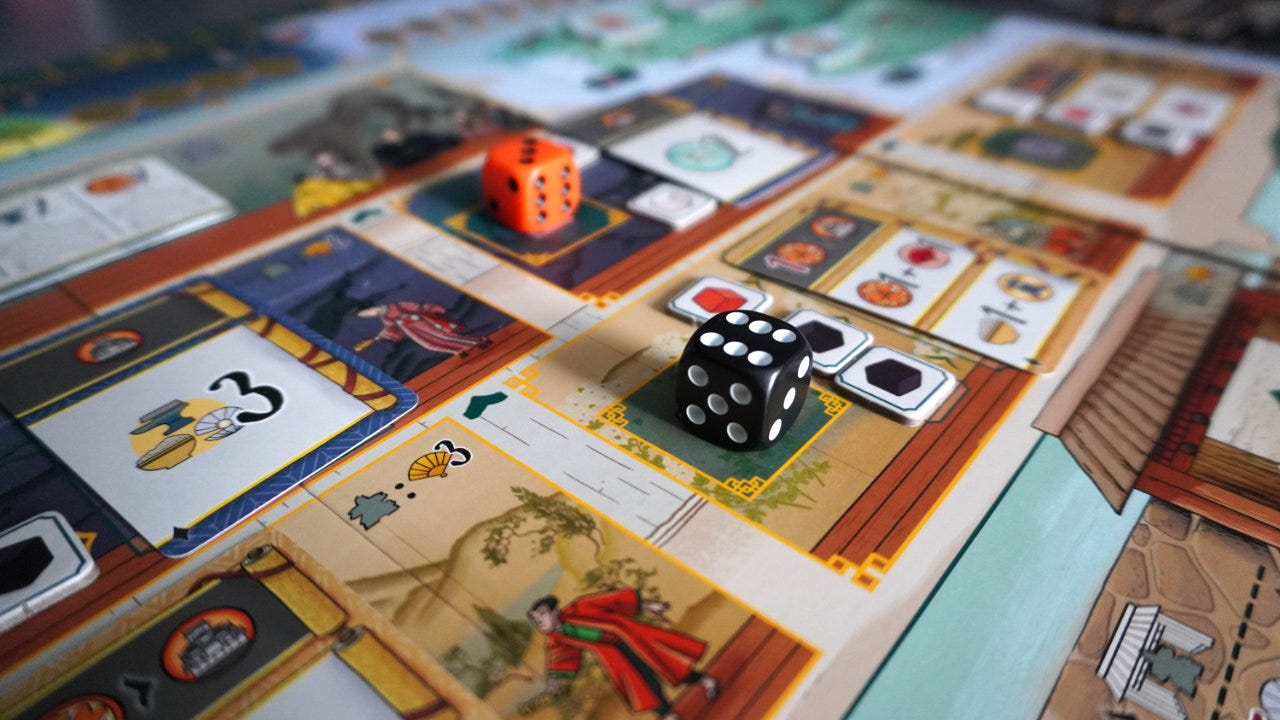
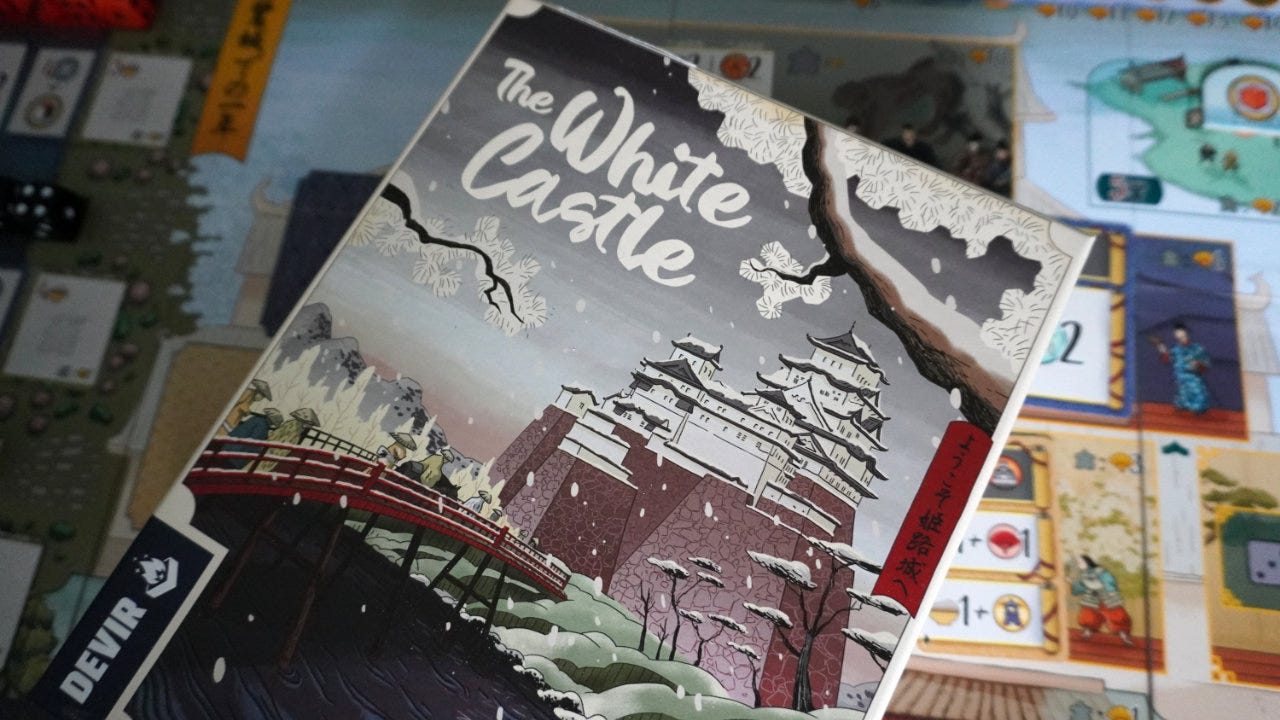

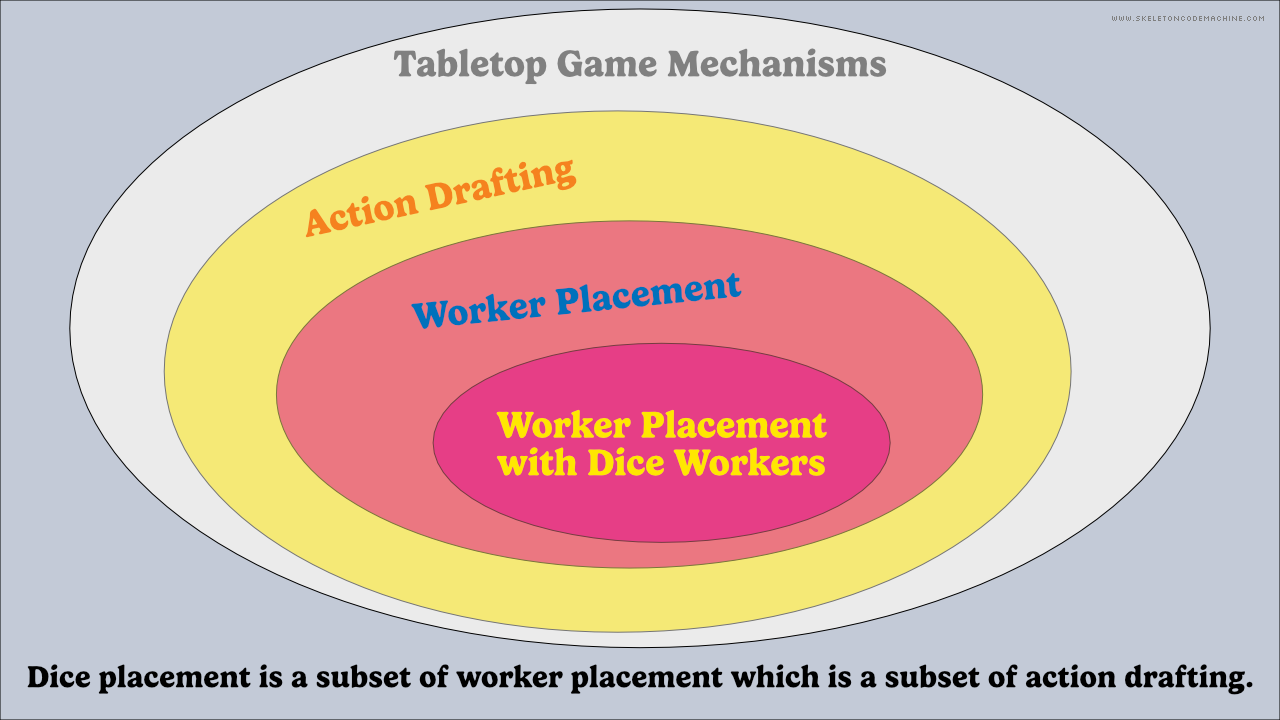

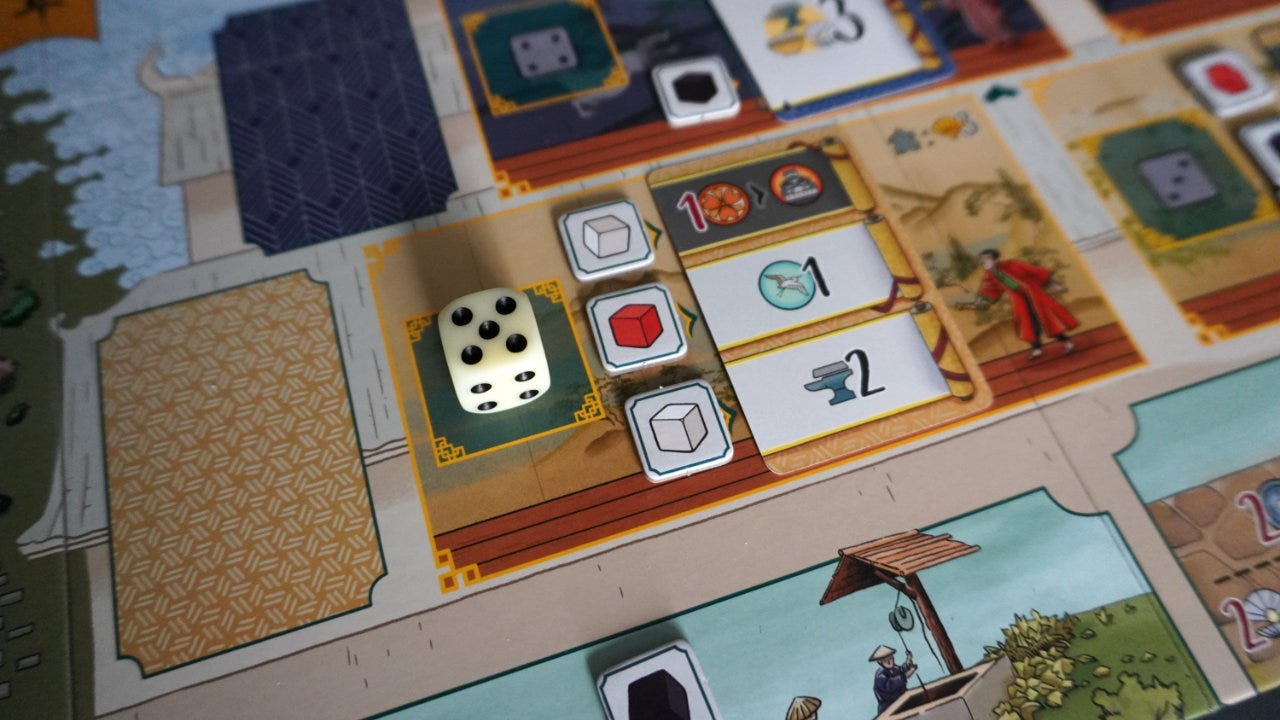
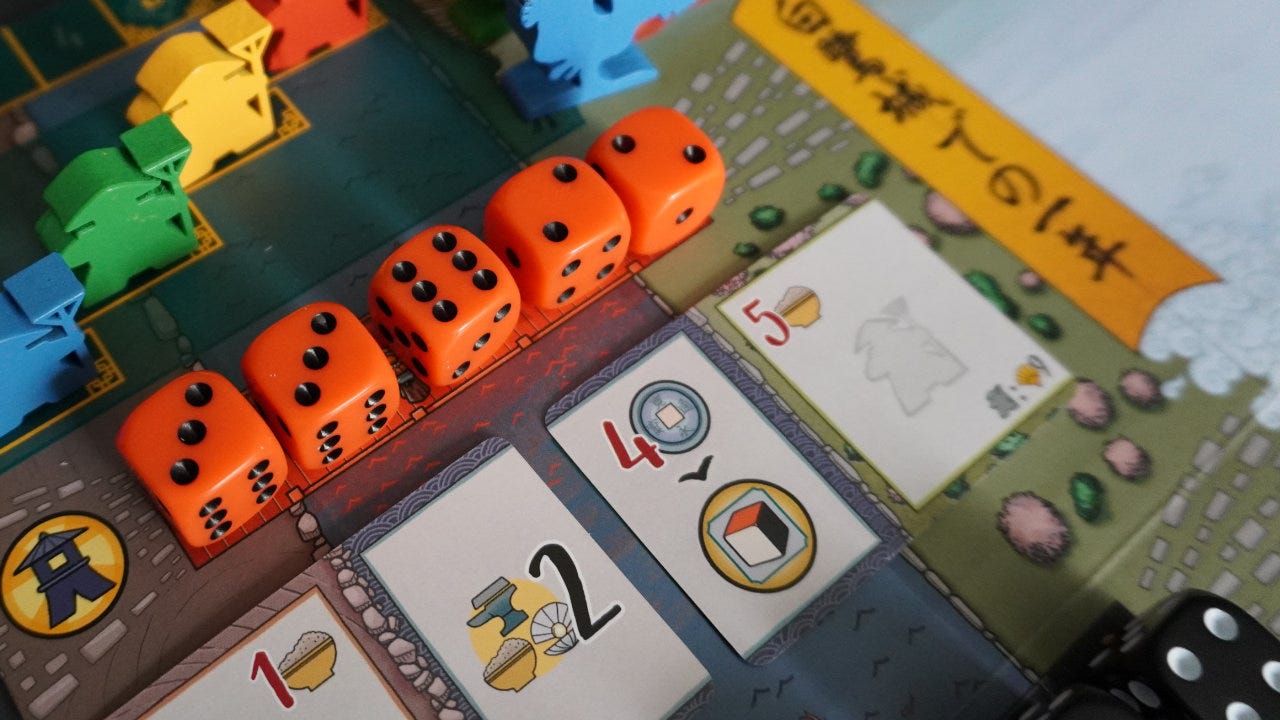
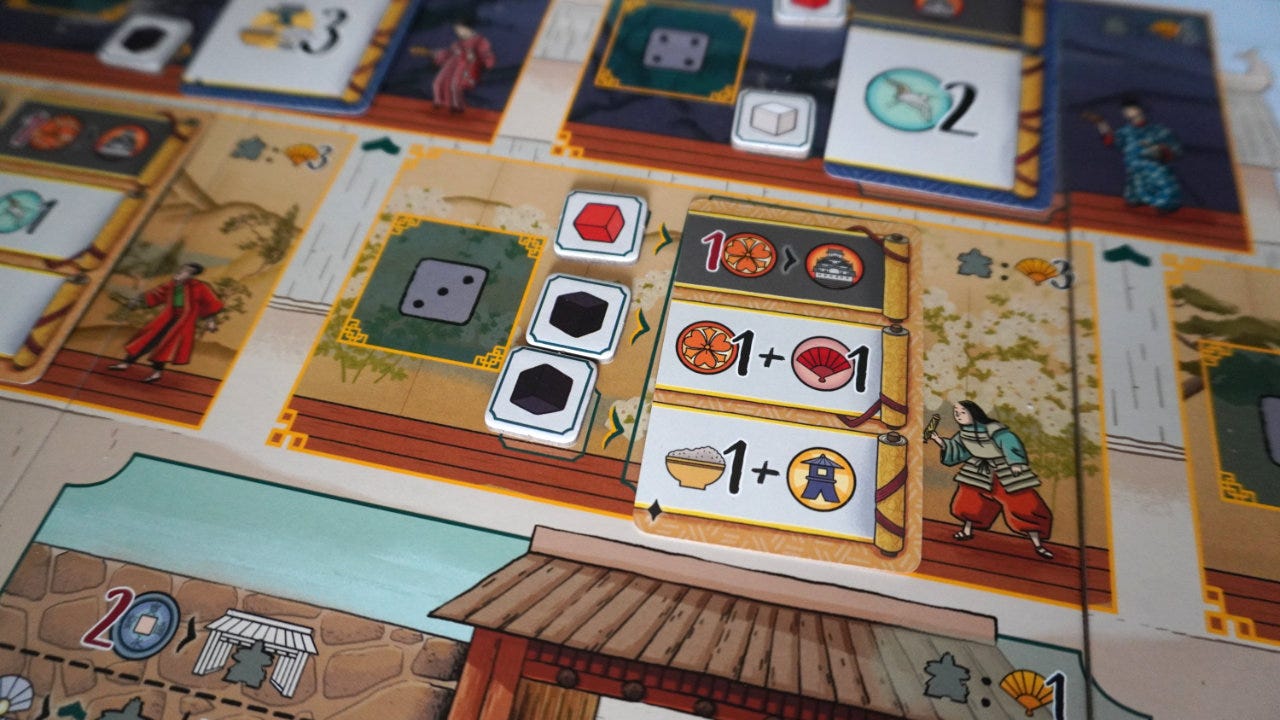
This made me think of one of my favorite uses of dice in a game, even though it's not action selection. Quantum uses dice as starships! When you roll your dice into your fleet, the result determines what kind of ship a die is (each ship has different speed and ability). Diceships get deployed on a map to roam around to control and defend territory. And when a ship is destroyed, the die comes back and eventually gets rolled again, potentially becoming something new. There are also ways to transform a ship into a different kind of ship using resources. Now I want to play Quantum.
while a quite different thing than dice placement per se, this still made me think of Otherkind Dice: https://lumpley.games/2022/03/14/otherkind-dice/
at first purely since it involves "placing" dice on 'outcome cards', but reading the article made me realise the concepts might actually be more similar in other ways too, like different results for different numbers on the dice, and giving a lot of player agency - there's even optional rules where dice colour (or size!) could be use for special dice :) though there are obvious differences, like rolling dice vs drafting them, board game and ttrpg, still super interesting to think about!